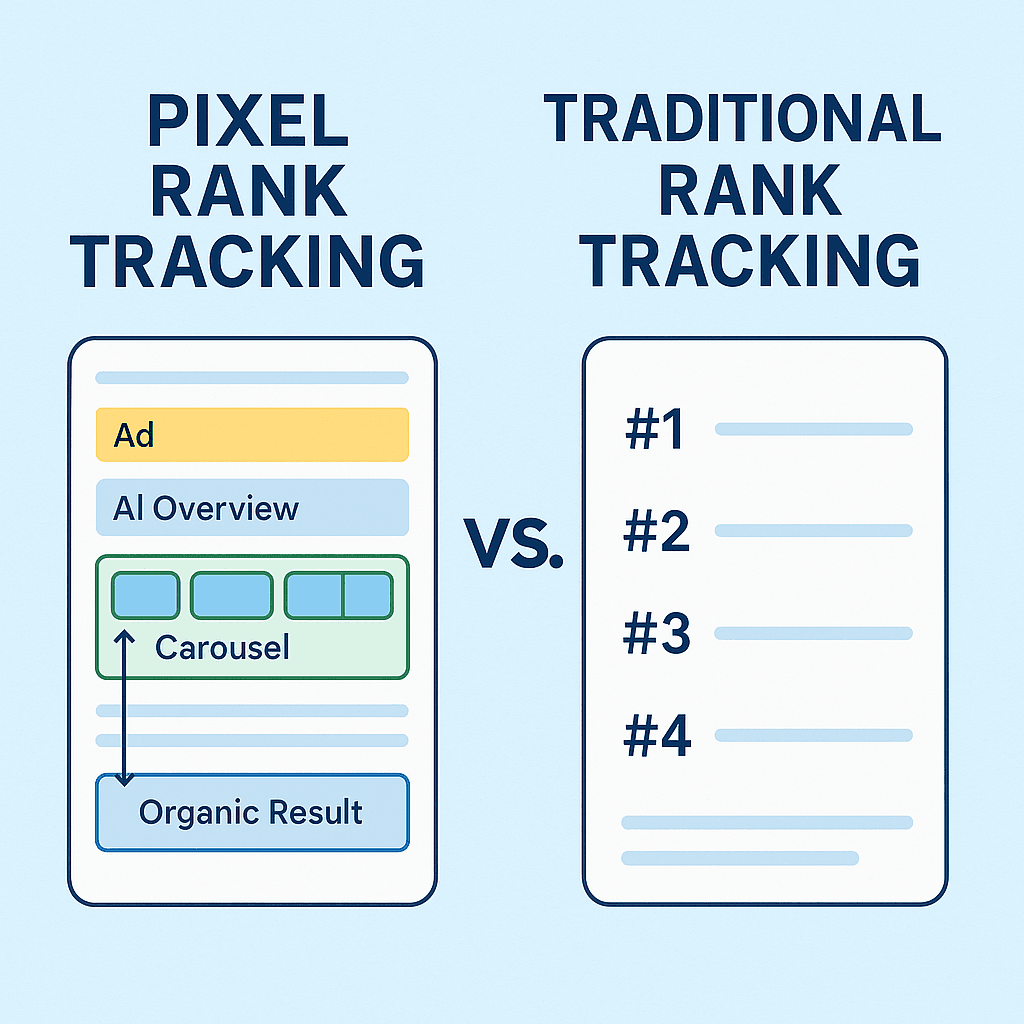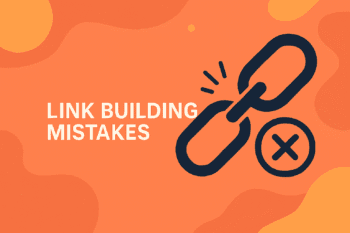Too Long, Didn’t Rank: The Summary
- Pixel rank tracking measures where your result appears on the screen, not just its numerical position.
- Traditional rankings ignore how features like AI Overviews, ads, or carousels bury organic links.
- Visibility today is about screen space, not rank — and that’s where pixel tracking wins.
- A visual ranking tool shows exactly how far down your listing appears across devices, helping you prioritize what users can actually see.
This article breaks down how pixel tracking works, its pros and cons, how it stacks against traditional rank tracking, and which tools provide the most accurate visibility insights.
The Ranking Trap: High Position, Low Visibility
Let’s say your page ranks #1 for a high-volume keyword. That used to be the goal. But today, a top position often lands you halfway down the page — buried under sponsored results, AI Overviews, featured snippets, “People Also Ask” boxes, and carousels.
In many SERPs, especially on mobile, users won’t even see your listing without scrolling. And if it’s below the 400–600 pixel mark, your result may as well be invisible to most users.
This is where traditional rank tracking falls apart. It tells you you’re still on top — but traffic is down, CTR is falling, and no one can explain why. The truth is, pixel rank tracking and SERP visibility metrics give a more accurate picture. They help you understand not just where you rank, but whether users can actually see your content.
Until you measure what users see, you’re just guessing.

Why Pixel Visibility Is More Relevant Than Ever
In modern SERPs, a #1 position doesn’t guarantee on-screen presence. Between AI answers, shopping units, and sponsored placements, your listing could be technically ranking high but showing up too low for users to notice — especially on mobile devices, where the visible area is much smaller.
Pixel SEO helps shift focus from rankings to presence. It answers practical questions like:
- Is the page visible on the initial screen load?
- How far down the SERP does the listing appear?
- What’s taking up the space above it?
- How likely is a user to interact with that result?
These considerations have become increasingly important as AI summaries show up across a growing number of searches. According to Ahrefs studies, top-ranking pages can lose up to 34% of clicks when an AI box is shown.
Visibility is no longer a given — it must be measured and optimized like any other performance metric.
What Is Pixel Rank Tracking?
Pixel rank tracking calculates the exact distance between the top of a search results page and your listing — measured in pixels. It factors in all the elements that appear before your content: ads, AI summaries, local packs, video thumbnails, and other SERP features.
Unlike conventional ranking tools that report your position by number, pixel-based tools estimate where the result physically sits on the page. A high-ranking result might still fall hundreds of pixels below the fold — especially on smartphones, where the first screen maxes out around 400 pixels.
If users don’t scroll far enough to reach it, that page may get little to no engagement. High rank, low visibility.

The Problem with Traditional Ranking Metrics
For years, position tracking has been the SEO standard. But a #1 rank in a cluttered SERP often means little — because visual placement trumps numerical order.
A listing can maintain its rank but suffer a traffic drop if new SERP features appear above it. These features — especially AI Overviews and sponsored blocks — dilute the value of ranking. And without a way to monitor screen-level positioning, those changes go unnoticed in your reporting.
Pixel rank tracking fills that gap, offering a more realistic measure of what users actually encounter when they search. It’s part of a larger shift away from gut-feel SEO toward smarter, data-backed strategies — what many now call SEO intelligence.
Diagnosing Pixel Tracking and SERP Visibility Issues
Pixel rank tracking uncovers why some well-optimized pages underperform. If results consistently show up below the fold, your issue might not be content depth or backlinks — it’s placement.
The first step to improving visibility is understanding what elements are keeping your pages out of view.
To fix that, focus less on adding more keywords or paragraphs. Instead, adjust formatting, explore schema opportunities, or update your media assets to better qualify for featured snippets and other high-visibility elements.
Want to improve how your content is structured for visibility? Learn more about editorial SEO best practices that help pages break through crowded SERPs.
From Rank to Real Estate: Measuring SERP Presence Accurately
Search visibility is no longer just about being on page one — it’s about where on the screen your listing appears.
Results that show up within the first screen load — known as above-the-fold content — receive most of the user’s attention. Those positioned lower require scrolling, which naturally leads to fewer impressions and lower click-through rates.
It’s also worth noting that screen visibility is layered. A featured snippet pulled from a lower-ranked page often gets more engagement than a plain blue link at the top. Visual prominence beats technical ranking.
Improving SERP Rank Tracking Visibility
Improving visibility isn’t about rank alone — it’s about occupying the most impactful space.
Start by targeting featured snippets with structured answers and question-based headings. Pages that win these often appear at the very top, even if they’re not ranked #1.
Next, optimize for rich results using schema markup. Adding FAQs, product specs, review stars, or how-to instructions can visually expand your listing, making it more noticeable and taking up more vertical space.
Also, look for opportunities to be cited in AI Overviews. These summaries often feature only a handful of trusted sources. Earning a spot here increases your chances of appearing in the most visible position on the page — regardless of your traditional rank.
Visibility also drives authority. The more on-screen exposure your content earns, the more likely it is to attract relevant backlinks — a vital signal in Google’s ranking system.
Choosing the Right Tracking Solution
Not all SEO tools are equipped to give you screen-level visibility data. Most still rely on traditional position tracking — which means they miss the nuance of how search results actually appear to users. That’s where a purpose-built visual ranking tool comes in.
When comparing platforms, don’t get distracted by flashy dashboards. Focus on whether the tool delivers actionable visibility insights, not just ranking reports.
Here’s what to look for in a tool designed to support pixel SEO and real user visibility:
- Pixel-depth tracking (desktop and mobile)
- Visual previews of SERP layout
- Fold-line estimation across screen sizes
- AI Overview and featured snippet detection
You don’t need ten different platforms. Instead, choose a visual ranking tool that integrates cleanly with your existing reporting stack and gives you user-centric metrics you can act on — especially if your team already tracks on-page and off-page optimization in parallel.
Limitations of Pixel Rank Tracking
Pixel tracking is a major step forward, but it has its caveats.
Device diversity means fold depth isn’t consistent across all users. A result that’s visible on a 1080p monitor might be hidden below the fold on a smaller phone. And while many tools simulate SERP layouts, few offer real-time screenshots, which means some pixel data may lag.
Still, the shift toward visual performance is long overdue. And for SEO teams looking to fine-tune their visibility, pixel rank tracking is a smarter way to see what really matters.
Final Thoughts: Visibility Is the Metric That Matters
Ranking first doesn’t mean you’re visible. In today’s search environment, what’s on screen matters far more than what position you hold.
Pixel rank tracking helps you understand how searchers actually encounter your content. It replaces blind assumptions with actionable visibility data — and that insight gives you a real edge.
If your SEO strategy still revolves around position alone, you’re missing the bigger picture. It’s time to measure what really matters: visibility — and support it with an ethical link building approach that earns authority without cutting corners.





